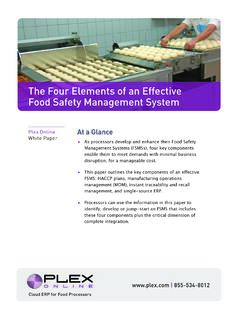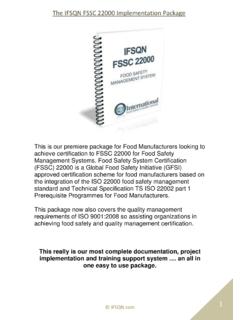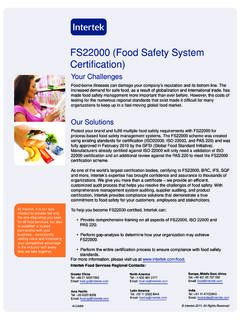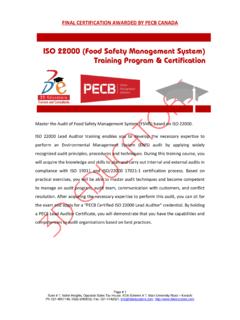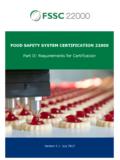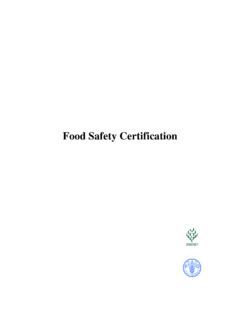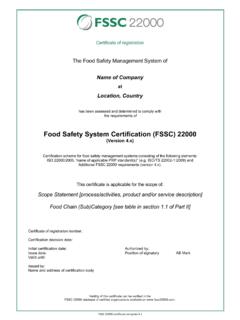Transcription of COMPARING GLOBAL FOOD SAFETY INITIATIVE (GFSI) …
1 COMPARING GLOBAL food SAFETY INITIATIVE ( gfsi ) recognised standards A DISCUSSION ABOUT THE SIMILARITIES AND DIFFERENCES BETWEEN THE REQUIREMENTS OF THE gfsi BENCHMARKED food SAFETY standards OCTOBER 2011 AUTHORSS upreeya Sansawat GLOBAL food Business Manager, SGSV ictor Muliyil Technical Manager for North America food SAFETY Services, SGS1I. EXECUTIVE SUMMARY 2II. THE GLOBAL food SAFETY INITIATIVE 3 III. gfsi recognised food SAFETY SCHEMES 5IV. A COMPARISON ON THE gfsi recognised SCHEMES 16V. COMBINING gfsi recognised SCHEMES WITH THOSE RELATED TO THE ENVIRONMENT, HEALTH & SAFETY AND QUALITY 24VI. CONCLUSION 25 CONTENTSABSTRACTThis document aims to provide an overview of the GLOBAL food SAFETY INITIATIVE ( gfsi ) and what it means for an international food SAFETY standard to be gfsi approved.
2 It then goes on to discuss each of the gfsi approved schemes individually looking in detail at the key schemes which are offered by the GLOBAL food Standard (BRC), FSSC 22000, the International Features Standard food (IFS food ), the Safe Quality food SQF 2000 and 1000 and the For each of these, the requirements, benefits and certification processes are reviewed. There are five further schemes that are covered in brief. The most generic of the schemes and those most commonly adopted by branded goods manufacturers (FSSC 22000, BRC, SQF 2000 and IFS) are then compared, by discussing the criteria, similarities and differences between the schemes. The paper then looks at the merits of a customised single food audit.
3 This could be of benefit because food SAFETY standards have an extensive crossover with environmental, health & SAFETY and quality standards . A further issue is that there is not necessarily one optimal fit food SAFETY standard for any given organisation. This means that a combination of schemes brought together in one audit procedure may be a more suitable , manufacturers, foodservice operators, caterers, industry associations, technical experts and governments all have one thing in common when it comes to food SAFETY . They recognise that consumers confidence dropped to an all time low after a number of public food scares sent shock waves through the industry just over ten years ago. As with many industries, this widespread concern for SAFETY prompted action.
4 Retailers began to audit their suppliers so that they could feel confident in their suppliers abilities to meet their food SAFETY system demands. This meant that suppliers often found themselves being repeatedly audited by individual retailers, creating a massive duplication of audit procedures. The industry soon came together to look at what could be done to improve the situation and reduce the strain on suppliers while maintaining the required SAFETY levels. While consumers needed a reassurance that the food they were purchasing and eating was guaranteed as safe for consumption, the unnecessarily repetitive audits needed to be reduced. Due to food supply chains stretching across the globe it was important that any industry solution covered both the end-to-end supply chain and influenced the industry on an international scale.
5 As a result of all these combined issues, the GLOBAL food SAFETY INITIATIVE ( gfsi ) was developed. All interested parties around the world joined forces to support the creation of a benchmarking and approval scheme that would lay the foundations for an industry-wide expectation in terms of food SAFETY management system deliverables. This became the benchmark against which all food SAFETY standards can be tested, in order to verify that the standard gained by an organisation was in fact proving that they produce or handle food at the level of SAFETY specified. Holding a gfsi approved certification is fast becoming an industry standard as more and more organisations within the industry are expecting entire supply chains for a given product to prove this capability.
6 Organisations audited and certified through a gfsi approved scheme increase their chances of being a chosen supplier to retailers and/or manufacturers who demand their suppliers hold a gfsi approved certification. The vision of the gfsi benchmark once certified, accepted everywhere is moving in the direction of being realised, both across the industry and across the world. With a number of international gfsi approved food SAFETY standards now available competitive suppliers are already certificated, seeking certification or developing their processes and identifying the best certification scheme for their organisation. The hope is that as certification becomes even more widespread consumer confidence will be fully restored and food scares will remain a thing of the past.
7 I. EXECUTIVE SUMMARY3 The GLOBAL food SAFETY INITIATIVE ( gfsi ) was originally set-up as a result of food SAFETY scares in early 2000. Its primary purpose is to ensure the SAFETY of food reaching all consumers internationally, but it also aims to develop efficiencies, promote transparency, guide cost savings and become a platform for continuous improvement in the area of food SAFETY . It does this by leading the GLOBAL food industry towards a harmonised approach to food SAFETY management the gfsi was established, retailers and major buyers across the food industry demanded specific food SAFETY requirements for particular products. To prove that these requirements were met food suppliers often had to have a number of different audits of their premises and systems, a process that cost them time and money.
8 From audit to audit there was also considerable duplication. This issue was dealt with, to some extent, by the industry developed national and regional schemes, such as the BRC or the IFS food standards . While these did aggregate the needs and demands of some buyers, there remained many instances of suppliers being audited through numerous a result of this continued duplication of audits the gfsi set out to develop a uniform structure for food SAFETY standards . It did this by detailing food SAFETY criteria that should be incorporated and putting common procedures in place for accreditation and certification bodies, which verified the implementation of this approach the gfsi aims to deliver on its mission to: Provide continuous improvement in food SAFETY management systems to ensure confidence in the delivery of safe food to consumers worldwide.
9 In order to do this effectively, it operates with four major objectives in mind:1. Reduce food SAFETY risks by delivering equivalence and convergence between effective food SAFETY management systems2. Manage cost in the GLOBAL food system by eliminating redundancy and improving operational efficiency3. Develop competencies and capacity building in food SAFETY to create consistent and effective GLOBAL food systems4. Provide a unique international stakeholder platform for collaboration, knowledge exchange and networkingThe gfsi is run by the Consumer Goods Forum, which brings together CEOs and senior management from 650 retailers, manufacturers, service providers and other stakeholders across the food industry.
10 Covering all areas in terms of both products and international locations the Forum is considered to be truly representative of the needs of the industry as a whole. Under the guidance of the Forum, governance of the gfsi is undertaken by a Board, various Technical Working Groups and a Stakeholder Group. While the Board sets the strategic direction and oversees the gfsi on a daily basis the Technical Working Groups provide technical expertise and advice. The Technical Groups combine to form a Technical Committee composed of retailers, manufacturers, food service operators, standard owners, certification bodies, accreditation bodies, industry associations and other technical experts. The gfsi Stakeholder Group brings retailers, manufacturers, certification bodies, accreditation bodies, standards owners, food SAFETY experts and consultants together in a forum to discuss issues related to the these interested parties have worked together to develop the gfsi Guidance Document.
